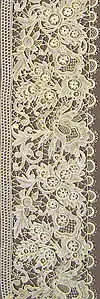

Needle lace is a type of lace created using a needle and thread to create hundreds of small stitches to form the lace itself.
Origins
The origins of needle lace date back to the 15th century and embroidery. Cutwork and drawn work were developed to add interest to white on white embroidery, and the methods used in these techniques led to needle lace.[1] : 56–57 A second expert puts the development of needle lace in the following century, the 16th, in Italy, also stemming from embroidery, the openwork on linen technique called reticella.[2] To show off their wealth in that period in Italy, the aristocracy favored wearing rich cloth embellished by embroidery and braid. As the century progressed, the small areas that were cut from the fabric to highlight the needle lace were replaced by much larger areas of cutwork. The needlework was dependent on remaining threads running vertically and horizontally, leaving squares and rectangles, which led to geometric designs.[3]: 17
Venice was a center of needle lace making in the 1400s, as documented by official records. In the 1500s, city officials decreed that young men in Venice were prohibited from lace wearing until they had turned 25.[1]: 57–58 Lace was a prized possession, appearing in lists of people's assets.[1]: 57–58
Materials
A variety of styles developed where the work is started by securing heavier guiding threads onto a stiff background (such as thick paper) with stitches that can later be removed. The work is then built up using a variety of stitches—the most basic being a variety of buttonhole or blanket stitch. When the entire area is covered with the stitching, the stay-stitches are released and the lace comes away from the paper.
Needle lace is also used to create the fillings or insertions in cutwork.
Structure
In its basic form, the only equipment and materials used are a needle, thread and scissors.
References
- 1 2 3 Bath, Virginia Churchill (1979). Lace. New York: Penguin Books.
- ↑ de Dillmont, Thérèse, ed. (1902). Needle-made Laces: 1st series. Mulhouse, France: Dollfus Mieg & Cie.
- ↑ Toomer, Heather; Voysey, Cynthia, eds. (1989). Lace: a guide to identification of old lace types and techniques. London: Batsford. ISBN 978-0-7134-5701-8.
- "Structures of Antique Lace". A Collection of Antique Laces. Retrieved July 26, 2005.
External links
- Kenmare Lace And other forms of Irish Lace
- Needlelace - Lace Identification and Types
- Old Point Lace: How to Copy and Imitate It (1878) by Daisy Waterhouse Hawkins. Chatto and Windus, London.
